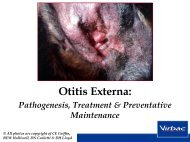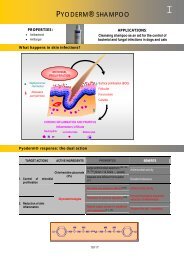FORMULATION OF AN ULTIMATE NUTRITIONAL SUPPLEMENT ...
FORMULATION OF AN ULTIMATE NUTRITIONAL SUPPLEMENT ...
FORMULATION OF AN ULTIMATE NUTRITIONAL SUPPLEMENT ...
Create successful ePaper yourself
Turn your PDF publications into a flip-book with our unique Google optimized e-Paper software.
21A diet supplement must be rich enough to guarantee the maintenance of an optimal ω6:ω3ratio mandatory for therapeutic results (refer to further discussion), and this, howeverdeficient or rich in FAs the basal diet of the animal is. Otherwise, this ratio will undergoimportant variations according to the animal’s diet.The recommended dosage of MEGADERM provides the required quantities of ω6 and ω3EFAs, talking about the ones that are useful, in other words LA, GLA, EPA and DHA.2. The ω6:ω3 ratioThe benefit of supplying EFAs from both families has been demonstrated, and theminimum quantity has been determined. The question is then : what is an appropriate ratioof proportions of ω6 and ω3 in a dietary supplementation? This is a debate among manyspecialists.The basic idea that was investigated, was that benefits could be provided by a “metabolic”overload of ω3 (EPA and DHA) with regard to the ω6. Many published work show theinfluence of variable ω6:ω3 ratios on the replacement of AA in the membranephospholipids by EPA, as well as on the EFA metabolic activities. 16,19,21 Maximal efficacyis obtained with diet supplements which ω6:ω3 ratios are included between 5:1 and 10:1,with a preference for the 5:1 ratio. 14-20 This ratio allows loading the cell membranes withω3, that will then be preferentially converted by the enzymatic systems, since the ω6 arepoorer competitors. With higher ratios (lower amounts of ω3), the ω6 metabolic pathway isfavoured, and the level of EPA is not sufficient enough to integrate the cell membranes andreplace AA, whereas this is perfectly achieved with the ratios mentioned above. Withlower ratios (small amounts of ω6), the beneficial effects of ω6 FA on skin integrity areconsiderably diminished (or even absent). It can also be assumed that in this case, thebeneficial influence of ω6 (GLA) on the eicosanoid cascade is notably diminished as well.Moreover, above a certain point, an excess of ω3 due to an inadequate supplementation ofω6, becomes toxic, and in particular gives rise to coagulopathies or immunodeficiencies.Other studies show that this optimal ratio provides an utmost anti-inflammatory efficacy,proved by a reduced production of LTB4 to the benefit of LTB5, without risking any sideeffectsobserved with higher levels of ω3, (ratio to low).MEGADERM, with a ω6:ω3 ratio of 5:1, has the optimal ratio. This ratio is meant inwords of useful EFAs : LA + GLA / EPA + DHA.
23II. DESCRIPTION <strong>OF</strong> THE PRODUCTA. MEGADERM Formula1. CompositionThe ω6:ω3 ratio is 5:1For 250 ml of product, the formula is the following:Linoleic acid (LA)Gammalinolenic acid (GLA)Eicosapentaenoic acid (EPA)Docosahexaenoic acid (DHA)Zinc91,2 g1,9 g11,2 g7,5 g505 mgVitamine AVitamine EVitamine B6Vitamine H (biotine)Inositol28700 UI950 UI25 mg472 µg85 mg2. Characteristics of the Emulsion• Colour : golden• Smell : fish oil• Consistency : thick drinkable liquid• Density : 0.95The product is formulated as an homogeneous emulsion of essential fatty acids, vitaminsand zinc that guarantees the best stability and maximal absorption of the product.3. Dosage of MEGADERMWith measure of 5 mlDosing chartPoids Number of measures per day< 10 kg 110 - 25 kg 225 - 45 kg 3> 45 kg 4It is recommended to use MEGADERM at least 6 weeks.4. Directions for use1. Take the cap off the bottle2. Squeeze the bottle until the doser (which is to be found on the top of the bottle underthe cap) fills automatically to 5 ml.3. Pour the needed amount of measures in your animal’s food, then mix it.Store away from light and a temperature below 30°C.
24B. The Packaging1. DescriptionMEGADERM is packed in a 250 ml PET bottle. Thanks to the physical properties ofPET? This bottle has a glass clear appearance. A colour UV-filter has be added to protectthe formula from UV action.MEGADERM is delivered thanks to an automatic 5ML dosing system.2. Advantages of the PET materialPET (the full name is PolyEthyleneTerephalate) is a thermoplastic polyester used firstly asa textile fibre and nowadays in food, water, cosmetics and pharmaceuticals packaging.The inherent leakproofness, light weight and resistance to physical damage of this materialmake it the “natural” material in Veterinary products.PET has a very good resistance against many chemicals.PET does not interact with the products that are packed in it, nor will it gave a taste, smellor flavour.PET has been registered as a safe material by FDA and other health institutions.PET can be easily recycled.3. Advantages of this automatic dosing system
25III. KEYPOINTS <strong>OF</strong> THE BENEFITS <strong>OF</strong> MEGADERM IN <strong>AN</strong>IMALSAFFECTED WITH SKIN DISEASES(refer to figure 2B)MEGADERM offers a large quantity of all the necessary EFAs among the sole ω6 andω3 families (the amount of detrimental FA is considerably reduced) according to theoptimal ratio (5:1) and in addition to their cofactors and antioxidants, within a galenicalinnovation.ω6 - Supplementation in LA is of direct structural benefit to the quality of the superficiallipid film and of the intercellular cement in the epidermis.In addition to improving skin integrity and epidermal barrier function, LA and GLAsupplements may also favour the production of anti-inflammatory mediators.ω3 - ω3 supplementation (EPA and DHA) engenders stock of EPA in cell membraneswhich ameliorates their fluidity and stability, and therefore reinforces skin integrity.Moreover, this supplement favours the production of anti-inflammatory mediators to thedetriment of pro-inflammatory mediators.Cofactors (VitA, VitB 6 , VitE, VitH, Zn) – The presence of cofactors enhances theeffects of these FA (refer to figure 2A). They are also beneficial in nourishing the skin andhaircoat.Antioxidants - The presence of antioxidants, as vitamin E, guarantee an optimalpreservation of the FA from the manufacture till their metabolic use.A liquid form - The liquid form is the most adequate form for delivering the desireddaily amount. This is explained by the fact that EFAs are present in liquid oils that cannotbe compressed or dehydrated. Therefore, for a certain amount of given EFAs, the liquidform is the one that fills the less volume. The administration is facilitated by the presenceof EFAs in a bottle with a delivery system since the administered dose may be spread overthe food.An innovative galenic - Galenical research has leaded to a drinkable emulsion, whichallows excellent stability of the product and improves the digestive biodisponibility of thesolubilised ingredients.MEGADERM is, amongst the EFA diet supplements, the most adequate formulaaccording to current knowledge and in respect of the goals coveted : improve skin and coatcondition, reinforce skin integrity, maintain efficient epidermal barrier function anddiminish clinical signs due to allergic conditions or keratinisation disorders.Furthermore, thanks to it’s richness as far as quality and quantity, for each of both families,the new MEGADERM formula is hardly influenced by any diet variation of FA. Thisformula preserves and grants all of its qualities even when added to the most deficient or“rich” diets.
26Because EFAs are uncommonly tolerable, MEGADERM offers an extremely highbenefice / security quotient, particularly when compared to other products that also includedrugs.A sole treatment with MEGADERM can sometimes be sufficient. General clinicalimprovement must be assessed after a few weeks (6 to 10) of daily administration.However, its prescription as an adjunctive therapy is of much benefit, principally forallergic conditions, but also for many other dermatoses, in particular when keratinisationdisorders are suspected. Subsequently, powerful molecules (antihistamines, NSAI,corticosteroids…) may be spared with the use of MEGADERM.MEGADERM is all of the following :- a fundamental basis to all dermatological therapies,- a skin and coat conditioner,- and a product to help maintaining the animals good health.However, the first product indication (ALLERDERM ) must be releated to dermatologicaluses : MEGADERM is a nutritional supplement particularly indicated to helpcontrolling skin allergies and keratinisation disorders in dogs and cats.MEGADERM acts by regulating the metabolic pathways that are responsible ofinflammatory processes, restoring skin integrity and improving haircoat quality. Morebroadly speaking, MEGADERM enhances the natural organic defences that maintain theanimal in good health.Based on dermatologist recommendations the ALLERDERM research has led to theelaboration of an adapted formula, rich and perfectly balanced.MEGADERM has all the ingredients fitting its indications. In particular, the type (ω6 andω3), the origin, the amounts and the ratio of EFA, as well as the generous incorporation ofvitamins A and E ensure the best benefits for the animal.REFERENCES1. WRIGHT S. & BURTON J. - (1982) - Oral evening primrose seed oil improves atopiceczema - Lancet 2 - 1120-22.2. CHAPKIN R., ZIBOH V. & MAC CULLOUGH J. - (1987) - Dietary influences of eveningprimrose and fish oil on the skin of essential fatty acids deficient guinea pigs - Journal ofnutrition - 117, 1360-70.3. MILLER W. - (1989) - Fatty acid supplements as anti-inflammatory agents - Kirk rw :current veterinary therapy X - Saunders - 563-5.4. MILLER W. - (1989) - Nonsteroidal anti-inflammatory agents in the management of canineand feline pruritus - Kirk rw : Current veterinary therapy X - Saunders - 566-9.
275. MILLER W., SCOTT O.W. & WELLINGTON J.R. - (1992) - Treatment of dogs with hipsarthritis with a fatty acid supplement - Canine practice - 17, 6-8.6. LLOYD D. & THOMSETT L. - (1989) - Essential fatty acid supplementation in thetreatment of canine atopy : a preliminary study - Veterinary dermatology - 1, 44.7. DAVIDSON B. & TRAHER C. - (1987) - The importance of essential fatty acid evaluationand supplementation in feline diets - Journal of the South African veterinary association - 58,39-41.8. BARRE D.E., HOLUB B. J. & CHAPKIN R.S. - (1993) - The effect of borage oilsupplementation on human platelet aggregation, Thromboxane B 2 , Prostaglandin E 1 and E 2formation - Nutrition Research - 13, 739-51.9. JENKINS D.K & al. - (1988) - Effects of different sources of gammalinolenic acid on theformation of essential fatty acid and prostanoid metabolites - J.Med.Res. - 16, 525-26.10. MC LE<strong>AN</strong> J. - (1981) - Essential fatty acids in the dog and cat - Veterinary Annual - 21, 167-70.11. MC DONALD M., ROGERS Q. & MORRIS J. - (1984) - Nutrition of the domestic cat, amammalian carnivore - Ann. Rev. Nutr. - 4, 521-62.12. SCOTT D. & BURGER R. - (1988) - Nonsteroidal anti-inflammatory agents in themanagement of canine pruritus - Journal of American Animal Hospital Association - 24,425-28.13. MEYER H. - (1986) - Grunddaten zur Rations-gastyltung bei Hund und Katze - Prakt.Tierazt - 67, 35-8.14. WOLTER V. M. - (1999) - L'acide gammalinolénique en nutrition comparée : applicationaux carnivores domestiques - Thèse ENV de Toulouse - 99 - TOU 3 - 4018.15. WOLTER R. - (1995) - Dermatose et alimentation chez les carnivores - Recueil de médecinevétérinaire - 171, 17-27.16. W<strong>AN</strong>DER R. C., HALL J. A., GRADIN J. L., DU S-H., & JEWELL D. E. - (1997) - Theratio of Dietary (n-6) to (n-3) Fatty Acids Influences Immune System Function, EicosanoidMetabolism, Lipid Peroxidation and Vitamin E Status in Aged Dogs - Nutritional Sciences -1198-205.17. BOUDREAU M.D., CH<strong>AN</strong>MUGAM R.S. HART S.B. & al. - (1991) - Lack of a n-3 to n-6fatty acid in suppressing eicosanoid biosynthesis from arachidonic acid - Am. J. Clin. Nutr. -54, 111-7.18. VAUGHN D.M., REINHART G.A., SWAIM S.F. & al. - (1994) - Evaluation of dietary n-6to n-3 fatty acid ratios on leukotriene B synthesis in dog skin and neutrophils. J. Vet. Intern.Med. - 8, 155.
2819. VAUGHN D.M., REINHART G.A., SWAIM S.F., LAUTEN S.D., GARNER C.A.,BOUDREAUX M.K., SP<strong>AN</strong>O J.S., H<strong>OF</strong>FM<strong>AN</strong> C.E. & CONNER B. - (1994) - Evaluationof Effects of Dietary n-6 to n-3 Fatty Acid Ratios on Leukotriene B Synthesis in Dog Skinand Neutrophils - Veterinary Dermatology - 5, (4), 163-73.20. BOUDREAUX M.K., REINHART G.A., VAUGHN D.M., SP<strong>AN</strong>O J.S. & MOONEY M. -(1997) - The Effects of Varying Dietary n-6 to n-3 Fatty Acid Ratios on Platelet Reactivity,Coagulation Screening Assays, and Antithrombin III Activity in Dog - J. Am. Anim. Hosp.Assoc. - 33, 235-43.21. LLOYD D.H. - (2000) - Essential fatty acids and the skin: Ten years of progress - CPDVeterinary Medicine - 2 (3), 85-90.
29FURTHER READING(references not included in the text)1. S. B. M. CHRISTIE, N. CONWAY <strong>AN</strong>D H.E.S. PEARSON - 1968 - Observations on theperformance of a standard exercise test by claudicants taking γ linolenic acid - J. Atheroscler. Res,83-90.2. H<strong>AN</strong>NSJORG W. SEYBERTH, M.D., OSWALD OEIZ, M.D., TOM KENNEDY, B.S., BRI<strong>AN</strong> J.SWEETM<strong>AN</strong>, Ph.D., ABRAHAM D<strong>AN</strong>ON, M.D., JURGEN C. FRÖLICH, M.D., MURRAYHEIMBERG, Ph.D., M.D. <strong>AN</strong>D JOHN A. OATES, M.D. - 1975 - Increased arachidonate in lipidsafter administration to man : Effects on prostaglandin biosynthesis - Clin Pharmacol Ther, 18 - 521-529.3. P.B.A. KERN<strong>OF</strong>F, A.L WILLIS, K.J STONE, J.A. DAVIES, G.P McNICOL - 1977 -Antithrombotic potential of dihomo-gamma-linolenic acid in man - British Medical Journal, 1441-1444.4. A.K. SIM <strong>AN</strong>D <strong>AN</strong>N P. McCraw - 1977 - The activity of γ-linolenate and dihomo-γ-linolenatemethyl esters in vitro and in vivo on blood platelet function in non-human primates and in man -Thrombosis research, 10 - 385-397.5. MEHAR S. M<strong>AN</strong>KU, DAVID F. HORRBIN, N<strong>AN</strong>CY MORSE, VICKI KYTE <strong>AN</strong>D KENNETHJENKINS, STEVEN WRIGHT <strong>AN</strong>D JOHN L. BURTON - 1982 - Reduced levels of prostaglandinprecursors in the blood of atopic patients : defective delta-6-desaturase function as a biochemicalbasis for atopy. Prostaglandins Leukotrienes and Medicine, 9 - 615-628.6. JO<strong>AN</strong> M. FISHER. D.R. DONEG<strong>AN</strong>. H.LEON <strong>AN</strong>D A. L. WILLIS - 1982 - Effects ofprostaglandins and their precursors in some tests of hemostatic function - Progr Lipid Ros, 20 - 799-805.7. B.A. SCHÖLKENS, D. GEHRING, V. SCHLOTTE <strong>AN</strong>D UK WEITHM<strong>AN</strong>N - 1982 - Eveningprimrose oil, a dietary prostaglandin precursor, diminishes vascular reactivity to renin and angiotensinII in rats - Prostaglandins Med, 8 - 273-86.8. J. J. F. BELCH, B. SHAW, A. O'DOWD, A. S<strong>AN</strong>IABADI, P. LEIBERM<strong>AN</strong>, R.D. STURROCK<strong>AN</strong>D C. D. FORBES - 1985 - Evening Primrose Oil (Efamol) in the Treatment of Raynaud'sPhenomenon : A Double Blind Study - Thrombosis and Haemostasis - F.K. Schattauer Verlag GmbH(Stuttgart), 54(2) - 490-494.9. JUKKA PUOLAKKA, M.D., LEO MÄKÄRÄINEN, M.D., LASSE VIINIKKA, M.D., OLAVIYLIKORKALA, M.D. - 1985 - Biochemical and Clinical Effects of Treating the PremenstrualSyndrome with Prostaglandin Synthesis Precursors, The Journal of Reproductive Medicine, 30 - 149-153.10. DESMOND J. FITZGERALD, M.B., LOUIS ROY, M.D., FR<strong>AN</strong>CESCA CATELLA, M.D. <strong>AN</strong>DGARRET A. FITZGERALD, M.D. - 1986 - Platelets activation in unstable coronary disease - Thenew England Journal of Medicine, 315(16) - 983-990.11. JOHN BETTERIDGE - 1987 - Nutrition and platelet in atherogenesis - Nutrition Society, 46 - 345-359.
3012. JOEL M. KREMER, M.D., WILLIAM JUBIZ, M.D., <strong>AN</strong>N MICHALEK, M.D., RICHARD I.RYNES, M.D., LEE E. BARTHOLOMEW, M.D., JE<strong>AN</strong> BIGAOUETTE, R.D., MARY<strong>AN</strong>NTIMCHALK, B.S.; DONALD BEELER, PhD, <strong>AN</strong>D LLOYD LININGER, PhD - 1987 - Fish-OilFatty Acid Supplementation in Active Rheumatoid Arthritis - Annuals of Internal Medicine, 106 -497-503.13. J.J. V<strong>AN</strong> DOORMAAL, I.G. IDEMA, F.A.J. MUSKIET, I.A. MARTINI <strong>AN</strong>D H. DOORENBOS -1988 - Effects of short-term high dose intake of evening primrose oil on plasma and cellular fatty acidcompositions, α-tocopherol levels, and erythropoiesis in normal and Type 1 (insulin-dependent)diabetic men - Diabetologia , 31 - 576-584.14. D. H. LLOYD - 1989 - Essential fatty acids and skin disease - Journal of Small Animal Practice 30 -207-212.15. G. HORNSTRA - 1989 - Influence of dietary fish oil on arterial thrombosis and atherosclerosis inanimal models and in man - Journal of Internal Medicine, 225 - 53-59.16. MIEKE D. TRIP, M.D., VOLKERT M<strong>AN</strong>GER CATS, M.D., FR<strong>AN</strong>S J.L. V<strong>AN</strong> CAPELLE, Ph.D.,<strong>AN</strong>D JOH<strong>AN</strong> VREEKEN, M.D. - 1990 - Platelet hyperreactivity and prognosis in survivors ofmyocardial infarction - The new England Journal of Medicine, 322(22) - 1449-1554.17. BARRY S. COLLER, M.D. - 1990 - Platelets and thrombolytic therapy - The new England Journalof Medicine, 322(1) - 33-42.18. J.A. DODGE - 1990 - Essential Fatty Acids in Cystic fibrosis - Omega-6 Essential Fatty Acids :Pathophysiology and Roles in Clinical Medicine, 427-435.19. DIDIER N. CARLOTTI, ISABELLE REMI ET CHRISTINE PROST - 1990 - Food Allergy in dogsand cats. A review and Report of 43 cases - Veterinary Dermatology, 1 - 55-62.20. M. KIETZM<strong>AN</strong>N, D. LUBACH - 1991 - Epidermal effects of evening primrose and cold watermarine fish oil in normal and essential fatty acid deficient mice - J. Anim. Physiol.a. Anim. Nutr., 66 -31-37.21. B. SILLIART, M.P. MONTRADE - 1992 - Eicosanoïdes (Prostaglandines, thromboxanes,leucotriènes et lipoxines) : Biologie et Perspectives thérapeutiques - pratique médicale et chirurgicalede l'animal de compagnie, 27(6) - 735-749.22. F<strong>AN</strong> Y. Y. & CHAPKIN R.S. - 1992 - Mouse Peritoneal Macrophage Prostaglandin E1 Synthesis isAltered by Dietary Gamma-Linolenic Acid - J. Nutr., 122, 1600-6.23. PRÉLAUD P. - 1992 - Utilisation des acides gras essentiels en Dermatologie des carnivores -L’action Vétérinaire - 1219, 11-4.24. BOURDEAU ET PARAGON - 1992 - Les acides gras polyinsaturés chez le chien et le chat - Rec.Med. Vet., 168/8/9 - 652.25. R. TAKAHASHI. J. INOUE, H. ITO <strong>AN</strong>D H HIBINO - 1993 - Evening Primrose Oil and Fish Oil inNon-Insulin-Dependent-Diabetes - Prostaglandins leukotrienes and essential fatty acids, 49 - 569-571.26. JJF BELCH, IR MACKAY, CS LAU, JW SHAW - 1993 - The role of essential fatty acids in theprevention of post-angioplasty restenosis - Results of a pilot study - Thrombosis and Haemostasis,69(6) - 1066.
3127. M. M. ENGLER - 1993 - Comparative Study of Diets Enriched with Evening Primrose, BlackCurrant, Borage or Fungal Oils on Blood Pressure and Pressor Responses in SpontaneouslyHypertensive Rats - Prostaglandins leukotrienes and essential fatty acids, 49 - 809-814.28. KENNETH W. KWOCHKA - 1993 - The Structure and Function of epidermal Lipids - VeterinaryDermatology, 4 - 151-159.29. JE BAUER - 1994 - The potential for dietary polyunsaturated fatty acids in domestic animals -Australian Veterinary Journal, 71 - 342-345.30. DAWN LOGAS & GAIL A. KUNKLE - 1994 - Double-blinded Crossover Study with Marine OilSupplementation Containing High-dose Eicosapentaenoic Acid for the treatment of Canine PruriticSkin Disease - Veterinary Dermatology, 5(3) - 99-104.31. LOWELL ACKERM<strong>AN</strong>, DVM - 1995 - Reviewing the biochemical properties of fatty acids -Veterinary Medicine, 1138-1155.32. SCOTT A. BROWN, DVM PhD - 1995 - Fatty Acid Supplementation and Chronic Renal Disease -Dietary Fatty Acid Supplementation. A New Treatment Modality - Veterinary Learning Systems Co.,Inc, 26-30.33. D<strong>AN</strong>IEL P. CAREY, DVM - 1995 - Introduction : Update on the Role of Fatty Acids in VeterinaryMedicine - Dietary Fatty Acid Supplementation. A New Treatment Modality - Veterinary LearningSystems Co., Inc, 7-10.34. JAMES N. MOORE DVM, PhD, MICHELLE HENRY BARTON, DVM, PhD, MARGARET E. MCC<strong>AN</strong>N, DVM - 1995 - Effect of Dietary α-Linolenic Acid on Responses of Horses to Endotoxin -Dietary Fatty Acid Supplementation. A New Treatment Modality - Veterinary Learning Systems Co.,Inc, 11-17.35. GREGORY A. REINHART, PhD - 1995 - Canine Dietary Fatty Acid Ratios and Tissue Fatty AcidContent - Dietary Fatty Acid Supplementation. A New Treatment Modality - Veterinary LearningSystems Co., Inc, 22-25.36. D<strong>AN</strong>A M. VAUGHN, PhD - 1995 - Dietary Fatty Acid Ratios and Tissue Eicosanoid Production -Dietary Fatty Acid Supplementation. A New Treatment Modality - Veterinary Learning Systems Co.,Inc., 18-21.37. GREGORY F. GRAUER, DVM, MS, DEBORAH S. GRECO, DVM, PhD, GREGORY A.REINHART, PhD - 1995 - Comparaison of the Effects of Dietary Omega-3 Fatty AcidSupplementation with Those of Thromboxane Synthetase Inhibition on Gentamicin-InducedNephrotoxicity in Dogs - Dietary Fatty Acid Supplementation. A New Treatment Modality -Veterinary Learning Systems Co., Inc, 31-35.38. JOHN E. BAUER, DVM, PhD - 1995 - Polyunsaturated Fatty Acids in the Management ofSpontaneous Canine Renal Disease - Dietary Fatty Acid Supplementation. A New Treatment Modality- Veterinary Learning Systems Co., Inc, 36-39.39. KAREN L. CAMPBELL, DVM, MS - 1995 - Fatty Acid Supplements in Dermatology - DietaryFatty Acid Supplementation. A New Treatment Modality - Veterinary Learning Systems Co., Inc, 40-45.
3240. JE<strong>AN</strong> A. HALL, DVM, PhD - 1995 - Potential Adverse Effects of Long-Term Omega-3 Fatty AcidConsumption - Dietary Fatty Acid Supplementation. A New Treatment Modality - VeterinaryLearning Systems Co., Inc, 46-52.41. PATRICIA D. WHITE, DVM, MS - 1995 - Essential Fatty Acids in Veterinary Medicine - BayerCorporation document, 1-48.42. DAWN LOGAS <strong>AN</strong>D GAIL A. KUNKLE - 1995 - Double-blinded Crossover Study with Marine OilSupplementation Containing High-dose Eicosapentaenoic Acid for the Treatment of Canine PruriticSkin Disease - Veterinary Dermatology, 5 - 99-104.43. PAMELA DELUCA, MD, DEBORAH ROTHM<strong>AN</strong>, PhD, MD, <strong>AN</strong>D ROBERT B. ZURIER, MD -1995 - Marine and botanical lipids as immunomodulatory and therapeutic agents in the treatment ofrheumatoid arthritis - Rheumatic disease clinics of North America, 21(3) - 759-777.44. K.C. DINES, M.A. COTTER, N.E. CAMERON - 1995 - Effectiveness of natural oils as sources of γ-linolenic acid to correct peripheral nerve conduction velocity abnormalities in diabetic rats:modulation by thromboxane A 2 inhibition - Prostaglandins Leukotrienes and Essential Fatty Acids,55(3) - 159-165.45. R.O. SCHICK, DVM, DACVD, MP SCHICK, DVM, <strong>AN</strong>D G.A. REINHART, PhD - 1995 -Efficacy of an omega-3 Fatty Acid adjusted diet in pruritic dogs - Food for Thought TechnicalBulletin, 55S - 164-165.46. WILLEM L. BLOK, MARTIJN B. KAT<strong>AN</strong> <strong>AN</strong>D JOS W. M. V<strong>AN</strong> DER MEER - 1996 -Modulation of Inflammation and Cytokine Production by Dietary (n-3) Fatty Acids - AmericanInstitute of Nutrition, 1515-1533.47. D.W. SCOTT <strong>AN</strong>D W. H. MILLER - 1996 - Primary seborrhoea in English springer spaniels : Aretrospective study of 14 cases - Journal of Small Animal Practice, 37 - 173-178.48. D<strong>AN</strong>NY W. SCOTT, WILLIAM H. MILLER JR., GREGORY A. REINHART, HUSSNI O.MOHAMMED, <strong>AN</strong>D MARY S. BAGLADI - 1997 - Effect of an Omega-3/Omega-6 Fatty Acid-Containing Commercial Lamb and Rice Diet on Pruritus in Atopic Dogs : Results of a Single-BlindedStudy - Can J Vet Res, 61 - 145-153.49. SUS<strong>AN</strong> O. McGUIRE <strong>AN</strong>D KEVIN L. FRITSHE - 1997 - The effect of dietary menhaden fish oil onα-tocopherol status in rodents is both concentration and tissue dependent - Nutritional Biochemistry,8 - 518-526.50. ERIC GUAGUERE - 1998 - Gestion des échecs thérapeutiques de la dermite atopique canine -L'action Vétérinaire, 1428 - 14-18.51. RODNEY A. H<strong>AN</strong>SEN, MS; GREGORY K. OGILVIE, DVM; DEBORAH J. DAVENPORT,DVM, MS; KATHY L. GROSS, PhD; JUDY A. WALTON; L. RICHARDSON, BS; CRAIG H.MALLINCKRODT, PhD; MICHAEL S. H<strong>AN</strong>D, DVM, PhD; MARTIN J. FETTM<strong>AN</strong>, DVM, PhD- 1998 - Duration of effects of dietary fish oil supplementation on serum eicosapentaenoic acid anddocosahexaenoic acid concentrations in dogs. - AJVR, 59(7) - 864-868.52. MARK A. MOONEY, MS, D<strong>AN</strong>A M. VAUGHN, PhD, GREGORY A. REINHART, PhD,ROBERT D. POWERS, DVM, PhD, JAMES C. WRIGHT, DVM, PhD, CHARLES E. H<strong>OF</strong>FM<strong>AN</strong>,STEVEN F. SWAIM, DVM, MS, HENRY J. BAKER, DVM - 1998 - Evaluation of the effects ofomega-3 fatty acid-containing diets on the inflammatory stage of wound healing in dogs - AJVR,59(7) - 859-863.
3353. OLE TAUGBOL, BABETTE BADDAKY-TAUGBOL <strong>AN</strong>D KRISTIN SAAREM - 1998 - TheFatty Acid Profile of Subcutaneous Fat and Blood Plasma in Pruritic Dogs and Dogs without SkinProblems - Can J Vet Res, 62 - 275-278.54. CARLOTTI D.N. - 1998 - Traitement et suivi au long cours du chien à dermatite atopique - PMCAC -33, 359-70.55. HALL J. A., W<strong>AN</strong>DER R.C., GRADIN J.L., DU SH., JEWELL D.E. - 1999 - Effect of dietary n-6 ton-3 fatty acid ratio on complete blood and total white blood cell counts, and T-cell subpopulations inaged dogs - AVJR, 60, 319-28.


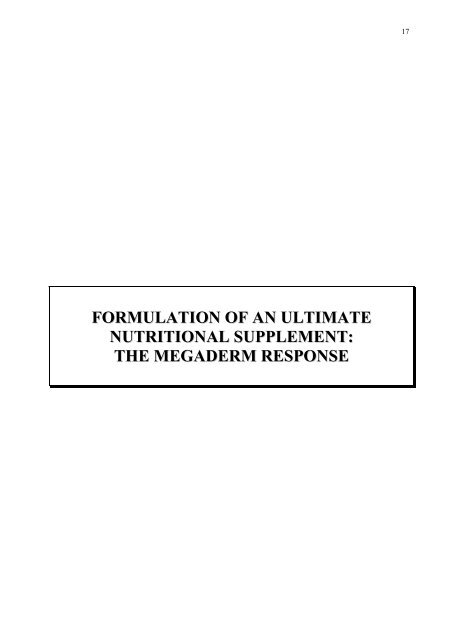
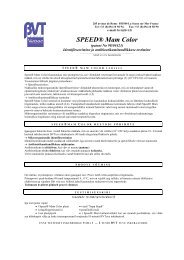
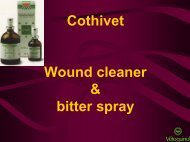

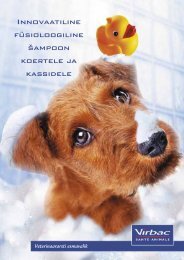
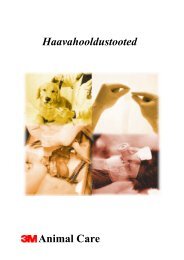
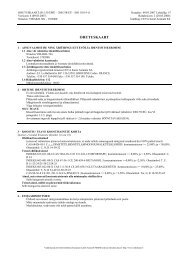


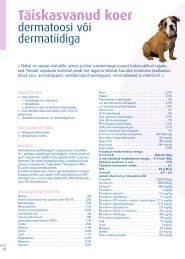
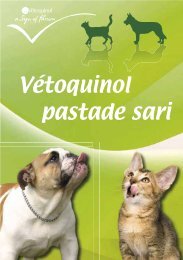
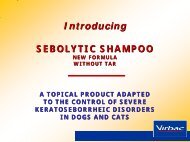
![[Version5.1 of 12/2002] LISA I RAVIMI OMADUSTE KOKKUVÕTE](https://img.yumpu.com/23062731/1/184x260/version51-of-12-2002-lisa-i-ravimi-omaduste-kokkuvaaote.jpg?quality=85)
